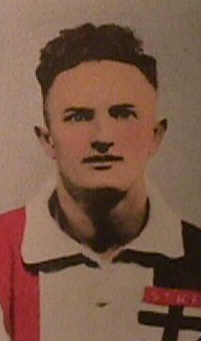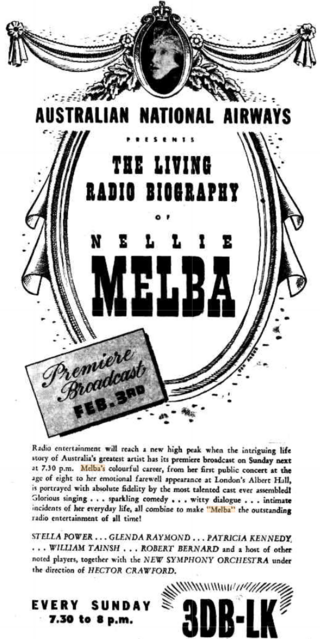Related Research Articles

KIIS 1011 is a commercial FM radio station broadcasting in Melbourne, Victoria, Australia, on a frequency of 101.1 MHz and is the Melbourne affiliate of ARN's KIIS Network. The station was formerly known as 3DB and 3TT, broadcasting on 1026 kHz AM, before converting to FM in 1990.
Ronald Grant Taylor was an English-Australian actor best known as the abrasive General Henderson in the Gerry Anderson science fiction series UFO and for his lead role in Forty Thousand Horsemen (1940).

The Athenaeum or Melbourne Athenaeum at 188 Collins Street is an art and cultural hub in the central business district of Melbourne, Victoria, Australia. Founded in 1839, it is the city's oldest cultural institution.

Keith John Rosewarne was an Australian rules footballer in the VFL.

Eureka Stockade is a 1949 British film of the story surrounding Irish-Australian rebel and politician Peter Lalor and the gold miners' rebellion of 1854 at the Eureka Stockade in Ballarat, Victoria, in the Australian Western genre.

Bush Christmas is a 1947 Australian–British comedy film directed by Ralph Smart and starring Chips Rafferty. It was one of the first films from Children's Entertainment Films, later the Children's Film Foundation.
Hector William Crawford CBE AO was an Australian entrepreneur, conductor and media mogul, best known for his radio and television production firms. He and his sister Dorothy Crawford founded Crawford Productions, which was responsible for many iconic programs and initiated the careers of a number of notable Australian actors and entertainers. His influence on the Australian entertainment industry was immense and enduring, and one obituary described him as "one of the best-known and most respected names in the history of Australian entertainment".
The Advocate was a weekly newspaper founded in Melbourne, Victoria in 1868 and published for the Catholic Archdiocese of Melbourne from 1919 to 1990. It was first housed in Lonsdale Street, then in the grounds of St Francis' Church, and from 1937 in a'Beckett Street, Melbourne.
Alan Burke was an Australian writer and film director and producer. His credits include the musical Lola Montez.
3DB was a Melbourne-based radio station that opened in 1927, changed its name to 3TT in 1988, and now operates on the FM band as KIIS 101.1.

Tertia Stella Power was an Australian soprano.
Viola Wilson was a Scottish singer, the leading soprano for J. C. Williamson's Gilbert and Sullivan company in Australia during World War II. She married the widowed theatre businessman Frank S. Tait, later Sir Frank.
Marie Alice Bremner was an Australian soprano, remembered for performances in Gilbert and Sullivan operas. She became a favorite performer in musical comedy, first on stage, then revivals and variety shows on broadcast radio. She was popular with producers for her ability to take on key roles at a moment's notice and draw "rave" reviews. Her accompanist husband Ewart Chapple became a senior executive with the Australian Broadcasting Commission.
Irene Gladys Mitchell was an Australian actor and theatre director, prominent in the little theatre movement in Melbourne.
In August 1928 the Collins Street Baptist Church was demolished to make way for a nine-storey building, at 203 Little Collins Street, midway between Swanston and Russell streets.
Peter Finch is an Australian actor whose career spanned more than forty years.
The Mask of Marius Melville is a 1946 Australian radio serial by Morris West.

Melba is a 1946 Australian radio drama about the life of Nellie Melba. and first broadcast by stations 3DB and 3LK 1946–1947 in fifty 30-minute episodes. It was produced by Hector Crawford, who knew Melba.
Glenda Raymond was an Australian soprano with a long career on radio and on stage in Melbourne, closely associated with conductor Hector Crawford, whom she later married.
The Mobil Quest was an Australian competition for operatic vocalists which ran from 1949 to 1957, sponsored by the Vacuum Oil Company and broadcast by Melbourne radio station 3DB and relayed to affiliates throughout Australia. It is remembered with wry amusement for judging Ronal Jackson the 1949 winner ahead of Joan Sutherland.
References
- ↑ "U.S. Keen on "Opera for the People"". The Herald (Melbourne) . No. 22, 320. Victoria, Australia. 3 December 1948. p. 5. Retrieved 24 December 2023– via National Library of Australia.
- ↑ "Quest for Singers". The Herald (Melbourne) . No. 21, 872. Victoria, Australia. 27 June 1947. p. 8. Retrieved 23 December 2023– via National Library of Australia.
- 1 2 ""Opera for the People"". The Herald (Melbourne) . No. 21, 577. Victoria, Australia. 16 July 1946. p. 9. Retrieved 17 December 2023– via National Library of Australia.
- ↑ "Today's Information Guide". The Herald (Melbourne) . No. 21, 697. Victoria, Australia. 3 December 1946. p. 17. Retrieved 23 December 2023– via National Library of Australia.
- ↑ "Today's Guide". The Herald (Melbourne) . No. 21, 709. Victoria, Australia. 17 December 1946. p. 17. Retrieved 23 December 2023– via National Library of Australia.
- ↑ "Today's Guide". The Herald (Melbourne) . No. 21, 715. Victoria, Australia. 24 December 1946. p. 11. Retrieved 23 December 2023– via National Library of Australia.
- ↑ "Today's Guide". The Herald (Melbourne) . No. 21, 721. Victoria, Australia. 1 January 1947. p. 11. Retrieved 23 December 2023– via National Library of Australia.
- ↑ "Today's Guide". The Herald (Melbourne) . No. 21, 732. Victoria, Australia. 14 January 1947. p. 15. Retrieved 23 December 2023– via National Library of Australia.
- ↑ "Today's Guide". The Herald (Melbourne) . No. 21, 744. Victoria, Australia. 28 January 1947. p. 13. Retrieved 23 December 2023– via National Library of Australia.
- ↑ "Today's Guide". The Herald (Melbourne) . No. 21, 909. Victoria, Australia. 9 August 1947. p. 19. Retrieved 23 December 2023– via National Library of Australia.
- ↑ "Today's Guide". The Herald (Melbourne) . No. 21, 784. Victoria, Australia. 15 March 1947. p. 17. Retrieved 23 December 2023– via National Library of Australia.
- ↑ "Operatic Role". The Herald (Melbourne) . No. 21, 855. Victoria, Australia. 7 June 1947. p. 2. Retrieved 23 December 2023– via National Library of Australia.
- ↑ "Today's Guide". The Herald (Melbourne) . No. 21, 867. Victoria, Australia. 21 June 1947. p. 19. Retrieved 23 December 2023– via National Library of Australia.
- ↑ "Eric Pearce, Narrator of "Opera for the People"". The Producer (Balaklava) . Vol. 40, no. 52. South Australia. 3 July 1947. p. 6. Retrieved 23 December 2023– via National Library of Australia.
- ↑ "Starring in Opera for the People". The Herald (Melbourne) . No. 21, 890. Victoria, Australia. 18 July 1947. p. 5. Retrieved 23 December 2023– via National Library of Australia.
- ↑ "Today's Guide". The Herald (Melbourne) . No. 21, 921. Victoria, Australia. 23 August 1947. p. 24. Retrieved 23 December 2023– via National Library of Australia.
- ↑ "Today's Guide". The Herald (Melbourne) . No. 21, 912. Victoria, Australia. 13 August 1947. p. 17. Retrieved 23 December 2023– via National Library of Australia.
- ↑ "Baritone Mixes Chess with Music". The Herald (Melbourne) . No. 21, 894. Victoria, Australia. 23 July 1947. p. 6. Retrieved 23 December 2023– via National Library of Australia.
- ↑ "Opera for the People: Botanic Gardens Performance". The Advocate (Melbourne) . Vol. LXXX, no. 4782. Victoria, Australia. 26 March 1947. p. 26. Retrieved 23 December 2023– via National Library of Australia.
- ↑ "Radio Party Drive". The Herald (Melbourne) . No. 21, 874. Victoria, Australia. 30 June 1947. p. 12. Retrieved 23 December 2023– via National Library of Australia.
- ↑ "£709 for YWCA". The Herald (Melbourne) . No. 21, 906. Victoria, Australia. 6 August 1947. p. 6. Retrieved 23 December 2023– via National Library of Australia.
- ↑ "Today's Guide". The Herald (Melbourne) . No. 21, 908. Victoria, Australia. 8 August 1947. p. 13. Retrieved 23 December 2023– via National Library of Australia.
- ↑ Lesley Morris (4 December 1946). ""Opera for the People" May Succeed". The Advocate (Melbourne) . Vol. LXXIX, no. 4766. Victoria, Australia. p. 42. Retrieved 23 December 2023– via National Library of Australia.